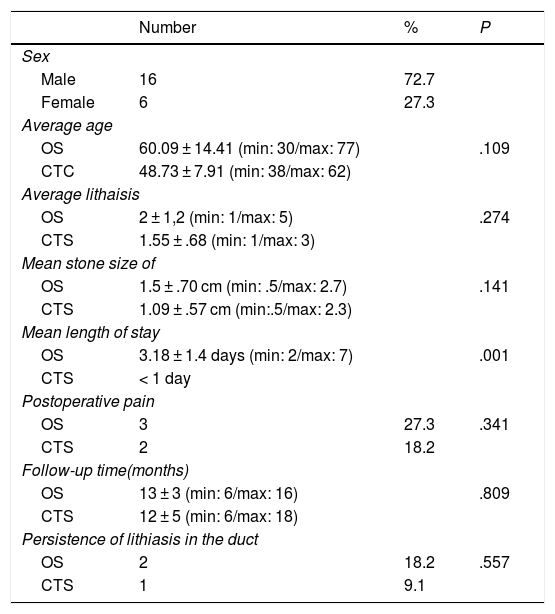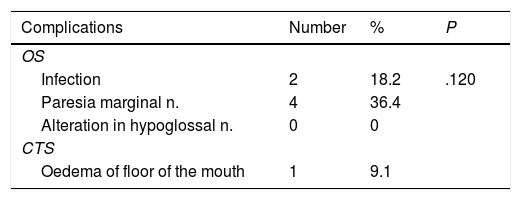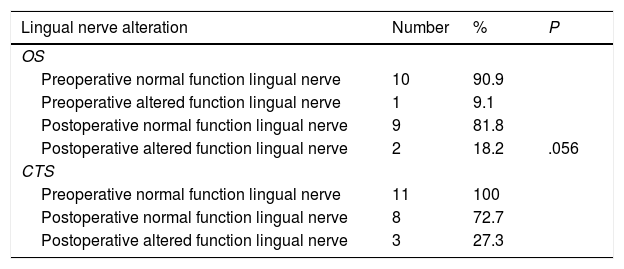The treatment of salivary obstructive pathology by minimally invasive techniques has been an object of assessment by different studies for decades. Lithiasis at the level of the salivary duct will be the most frequent cause of obstruction, representing more than 50% of the pathology of the major salivary glands and almost 80% of these affecting the Wharton duct.
Material and methodsA Prospective study comparing the results of combined transoral sialolitectomy and open submaxillectomy techniques by cervicotomy in 2 groups of patients treated by lithiasis at the level of the hilum of the submaxillary gland.
Results22 patients were included in the study 16 (72.7%) were men and 6 (27.3%) were women, the average age was 54.41 years ± 12.75 (Min: 30/Max: 77). Regarding the variables associated with the disease: average lithiasis, size of the stone, hospital stay, lingual nerve alteration or complications for both techniques, differences were not found between both groups. There were only statistically significant differences in the average stay in favor of the STA (P = .001).
ConclusionThe minimally invasive approaches to the salivary ductal system, associated or not with sialoendoscopy, can be efficacy and can be associated with lower number of complications. The natural tendency should be aimed to gradually replacing open sialoadenectomy techniques, reserving its indication for the treatment of tumor pathology.
El tratamiento de la patología obstructiva salival mediante técnicas mínimamente invasivas ha sido objeto de valoración por diferentes estudios desde hace décadas. Las litiasis a nivel del conducto saliva serán la causa más frecuente de obstrucción representando más del 50% de la patología de las glándulas salivales mayores afectando hasta en un 80% de casos al conducto de Wharton.
Material y MetodosEstudio prospectivo, comparando los resultados de las técnicas de sialolitectomía transoral combinada (STC) y submaxilectomía abierta mediante cervicotomía (SA) en 2 grupos de pacientes tratados por cálculos a nivel del hilio de la glándula submaxilar.
Resultados22 pacientes fueron incluidos en el estudio 16 (72,7%) eran hombres y 6 (27,3%) eran mujeres, la edad promedio fue de 54,41 años ± 12,75 (Min: 30/Max: 77). En cuanto a las variables asociadas a la enfermedad: promedio de litiasis, tamaño medio de la litiasis, tiempo medio de estancia, alteración del nervio lingual o complicaciones para ambas técnicas, no se encontraron diferencias para ambos grupos. Existiendo solo diferencias estadísticamente significativas en la estancia promedio a favor de la STA (p = 0,001).
ConclusiónLos abordajes mínimamente invasivos al sistema ductal salival, asociados o no a sialoendoscopia, han demostrado una eficacia contrastada y un menor numero de complicaciones en su variante submaxilar transoral. La tendencia natural debería ir dirigida a sustituir paulatinamente las técnicas de sialoadenectomía abierta, reservando su indicación para el tratamiento de patología tumoral.
Artículo
Comprando el artículo el PDF del mismo podrá ser descargado
Precio 19,34 €
Comprar ahora









